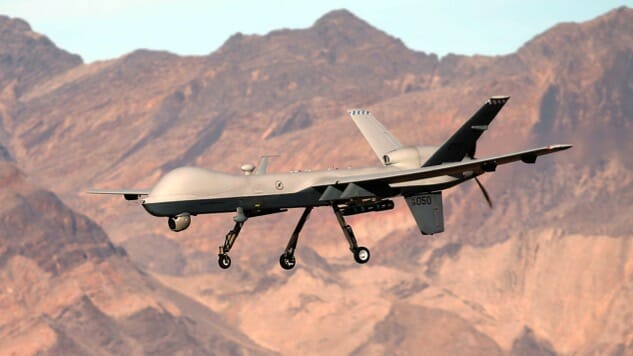
According to a recently released database from The Center for New American Security—a think tank that develops national security and defense policies—and the Bard College Center for the Study of the Drone, over 45 countries have currently developed drones for surveillance, military, or other purposes.
While around 10 countries have armed drones currently, 20 more are in the process of developing weaponized drones. This includes countries such as Iran, Russia, and China.
According to Fars News, Iran is currently using drones such as the Shahed 129, with its “significant payload capacity,” to support forces in Syria, while Russia has developed surveillance drones that it integrates with its artillery battalions to make them more accurate. It’s possible the number of countries with militarized drone programs are underestimated though.
“That line between drones and ‘weaponized’ drones is becoming less clear, given it’s becoming easier to outfit drones with weapons or purchase military drones from countries like Israel or China as an alternative,” says Paul Scharre, a senior fellow and director of the Future of Warfare Initiative at the Center for New American Security.
While the American experience of drones has largely centered around our military’s capability to use them against remote non-state actors, such as terrorist groups, that has changed in recent years.
Reports in January showed jihadi fighters’ drones dropping explosives on Iraqi forces during the battle for Mosul. According to the BBC, the tactic involves using quadcopters to drop grenades from above the battlefield.
Despite the proliferation of drones, countermeasures against them are still relatively new.
“Even though we see proliferation happening every day, we are still in the early stages of proliferation,” says Dan Gettinger, Co-founder of the Center for the Study of the Drone at Bard College. “Because there haven’t been cases where two well-equipped drone armies go at each other, we aren’t at a point where we can say this is what happens when you have all these unmanned aircraft systems from different countries flying in the same airspace.”
Countries and companies are beginning to think about a future that might resemble that scenario.
Battelle, a private company, has developed the DroneDefender rifle, which is specifically designed to take out unmanned aircraft systems. The rifle, when fired, severs the communication lines between the drone and its pilot, effectively neutralizing it. The United States military has already equipped some of its troops with this product, and Battelle is currently exclusively selling the DroneDefender rifle to them. Another handheld option is OpenWorks’s SkyWall, an anti-drone cannon that shoots nets and was demoed in 2016. The weapon can be handheld, mounted on a stand, or even deployed as a turret. In addition to the more mundane nets it can fire, one of its projectile nets comes equipped with electronic counter measures.
China, meanwhile, has also been developing an ambitious drone program called “Divine Eagle”. The program is working on a large drone whose purpose is to detect and hunt stealth aircraft, including stealth drones. The benefit of this drone would largely be in a conflict where two countries at war both possess drones capable of attacking the other. The first recorded flight of “Divine Eagle” was in February of 2015. As Jeffrey Lin and P.W. Singer wrote in Popular Science, as the Divine Eagle “planned to hunt stealth planes from afar, it could turn out to be not just the world’s largest drone, but one of the most important to the future of war.”
The US military has also been exploring more advanced systems that would allow it to counter drones. In a 2016 request for information, the Defense Advanced Research Projects Agency (DARPA) expressed interest in “exploring the potential for developing and demonstrating system solutions, including sensors and effectors, to enable detection, identification, tracking, and neutralization of sUAS threats”. They want something that could counter drones, other conventional weapons, and could be mobile and easily updated as more advanced weapons and tech are developed.
Finally, as Wired recently reported, one private company is working to develop a system that could monitor an airspace, tell if something is a drone, and then use frequency jammers to take it down, disabling its communications with its pilot. The system could be used to protect buildings, or even a public space like a football stadium, as the developers have demoed previously. Unfortunately, such a system would run counter to numerous Unites States laws and is currently illegal.
The spread of drones is something that generally flies under the radar of public consciousness. As militarized drones continue to be developed elsewhere though, the thinking around countermeasures needs to catch up to the reality that the US won’t be the only ones deploying drones regularly in the future.